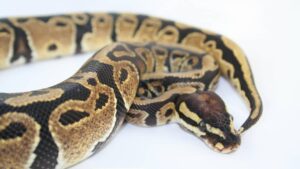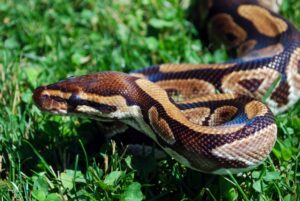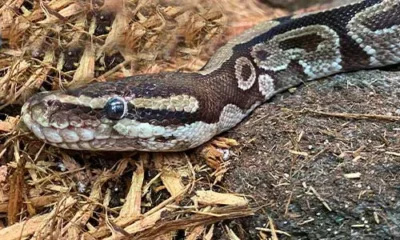Can ball pythons live together? This question often arises among reptile enthusiasts considering housing multiple ball pythons in the same enclosure. The inquiry delves into the intricate dynamics of these fascinating creatures’ social behaviors and habitat preferences.
Ball pythons are generally solitary animals and are known to be solitary in the wild. While some snake species can tolerate living together in pairs or small groups, attempting to house ball pythons together can often lead to stress, aggression, and even injury or death.
There are rare instances where ball pythons may cohabitate peacefully, especially if they are young and raised together from hatchlings. However, even in such cases, there’s always a risk of aggression or competition, particularly during feeding time or when one snake is shedding.
Can ball pythons live together?

While it’s technically possible for ball pythons to live together, it’s generally not recommended for several reasons:
- Stress and Aggression: Ball pythons are solitary creatures by nature, and they may exhibit stress or aggression when housed together. Competition for resources like food, hiding spots, and territory can lead to conflicts.
- Injuries and Cannibalism: Even if they seem to get along initially, ball pythons can turn aggressive towards each other, resulting in injuries or even cannibalism, especially during feeding time.
- Spread of Disease: Close proximity increases the risk of spreading diseases and parasites between snakes, even if they appear healthy.
- Difficulty Monitoring: It can be challenging to monitor the health and behavior of each snake when they are housed together, potentially leading to overlooked health issues.
- Breeding Concerns: If you have both male and female ball pythons, they may breed, leading to unexpected pregnancies and the responsibility of caring for offspring.
If you want to keep multiple ball pythons, it’s safer and more humane to house them separately in appropriately sized enclosures with proper temperature, humidity, and enrichment. This ensures each snake’s well-being and minimizes the risks associated with cohabitation.
Social Nature of Ball Pythons
While ball pythons are generally solitary in the wild, they do exhibit some social behaviors, especially during mating and occasionally when basking or huddling together for warmth. However, these social interactions are usually limited, and ball pythons are primarily solitary hunters and dwellers.
In captivity, some keepers have observed instances where ball pythons tolerate being housed together without displaying aggression. This is more likely to occur when the snakes are raised together from a young age, accustomed to each other’s presence, and provided with ample space, hiding spots, and resources.
However, even in these cases, it’s crucial to monitor the snakes closely for any signs of stress, aggression, or health issues. Providing separate enclosures is generally recommended to ensure each snake’s well-being and minimize potential conflicts.
Ultimately, while ball pythons may exhibit limited social behaviors, they are primarily solitary animals, and their well-being should be prioritized through appropriate housing and care practices.
Understanding social interactions among ball pythons
Ball pythons, while primarily solitary in the wild, do exhibit some social behaviors, especially during certain times and circumstances. Here are a few aspects to consider:
- Mating: Ball pythons come together for mating purposes during the breeding season. Male ball pythons will actively search for females, often utilizing scent trails and pheromones to locate potential mates. While mating, they engage in courtship rituals, which can involve body movements and even gentle biting.
- Basking Sites: Ball pythons may sometimes gather in areas with suitable basking spots, such as rocky outcrops or sunny patches. While they’re not actively interacting in these situations, they may tolerate each other’s presence due to the favorable conditions.
- Hiding Spots: In both captivity and the wild, ball pythons may share hiding spots, especially during periods of rest or when seeking refuge from predators or adverse environmental conditions. However, this doesn’t necessarily indicate social behavior but rather a response to environmental stimuli.
- Huddling for Heat: Ball pythons may occasionally huddle together, particularly in captivity where they have limited space and resources. This behavior is more about thermoregulation than social interaction, as they seek warmth from each other’s bodies.
- Limited Tolerance: While ball pythons may exhibit some social behaviors, they generally have a low tolerance for prolonged interaction with conspecifics, especially outside of mating or basking contexts. In captivity, attempts to house them together often result in stress, aggression, and potential injury.
Overall, while ball pythons may display occasional social behaviors, they are primarily solitary animals that prefer to live and hunt alone. Understanding their natural behaviors can help provide appropriate care and housing in captivity while respecting their need for solitary living.
Factors to Consider Before Housing Ball Pythons Together

Before considering housing ball pythons together, it’s important to carefully weigh several factors to ensure the well-being of the snakes. Here are some key considerations:
- Individual Temperament: Each ball python has its own personality and temperament. Some individuals may be more tolerant of conspecifics, while others may be territorial or aggressive. It’s essential to know the temperament of each snake before attempting to house them together.
- Size and Age: Ball pythons of similar size and age are more likely to cohabitate peacefully. Large size disparities or significant age differences can lead to dominance issues, with larger or older snakes potentially bullying or injuring smaller or younger ones.
- Sex: Housing male and female ball pythons together can lead to mating behavior, which may result in unwanted pregnancies and the responsibility of caring for offspring. Additionally, male ball pythons may become aggressive towards each other, especially during breeding season.
- Health Status: Only healthy snakes should be considered for cohabitation. Sick or immunocompromised individuals are more susceptible to stress and disease, and housing them together can exacerbate these issues.
- Space and Resources: Each snake requires its own space, including hiding spots, basking areas, and feeding stations. Overcrowding can lead to stress, competition for resources, and aggression. Ensure that the enclosure is large enough to accommodate all snakes comfortably.
- Monitoring: Cohabitating snakes need to be monitored closely for any signs of stress, aggression, or health problems. Regular observations can help identify issues early and prevent serious conflicts or injuries.
- Separation Options: Have a plan in place to separate the snakes if necessary. This could involve providing multiple hiding spots and basking areas within the enclosure or having separate enclosures ready in case conflicts arise.
- Alternative Arrangements: Consider whether cohabitation is truly necessary or beneficial for the snakes. In many cases, ball pythons thrive best when housed individually, allowing for customized care and minimizing the risk of conflicts and stress-related health issues.
By carefully considering these factors and providing appropriate housing and care, you can make an informed decision about whether to house ball pythons together and ensure the well-being of your snakes.
Risks and Challenges of Keeping Ball Pythons Together
Keeping ball pythons together can pose several risks and challenges, including:
- Aggression: Ball pythons are solitary by nature and may exhibit aggression towards each other, especially during feeding time or mating season. This aggression can lead to injuries or even death.
- Stress: Cohabitating ball pythons may experience stress due to competition for resources such as hiding spots, basking areas, and food. Chronic stress can weaken the immune system and make snakes more susceptible to illness.
- Disease Transmission: Close proximity increases the risk of transmitting diseases and parasites between snakes. Even if one snake appears healthy, it may be a carrier of pathogens that can affect others.
- Food Competition: When housed together, ball pythons may compete for food, leading to uneven feeding patterns or incomplete meals. This can result in malnutrition for some individuals and overeating for others.
- Breeding: If both male and female ball pythons are kept together, there’s a risk of unplanned breeding, which can lead to unwanted pregnancies and the responsibility of caring for offspring.
- Monitoring Challenges: It can be challenging to monitor the health and behavior of each snake when housed together. Signs of illness or injury may go unnoticed, leading to delayed treatment.
- Space Requirements: Cohabitating ball pythons require a larger enclosure to accommodate their individual needs, including hiding spots and basking areas. Providing adequate space can be challenging, especially for multiple snakes.
- Individual Care Needs: Each ball python has its own unique care requirements, including temperature, humidity, and feeding preferences. Meeting these needs for multiple snakes can be more complicated when housed together.
- Handling Difficulties: Cohabitating ball pythons may become defensive or agitated when handled, especially if they feel threatened by the presence of other snakes. This can make routine maintenance tasks more challenging.
Considering these risks and challenges, many reptile experts recommend housing ball pythons separately to ensure their well-being and minimize the potential for conflicts and stress-related health issues.
Benefits of Keeping Ball Pythons Together

While it’s generally recommended to house ball pythons separately due to the risks and challenges associated with cohabitation, there are some potential benefits under specific circumstances:
- Company and Social Interaction: Some ball pythons may exhibit limited social behaviors, and keeping them together can provide companionship and social interaction. This can be particularly beneficial for young snakes raised together from hatchlings.
- Reduced Stress from Isolation: In certain cases, cohabitation might reduce stress for individual snakes, especially if they have been raised together and are accustomed to each other’s presence.
- Observational Learning: Cohabitating snakes may learn from each other’s behaviors, such as hunting techniques or thermoregulation methods. This can be especially relevant for juvenile snakes learning essential survival skills.
- Stimulating Environment: Having multiple snakes in the same enclosure can create a more stimulating environment with increased sensory input. This can be enriching for the snakes and may help prevent boredom.
- Space Efficiency: Housing multiple snakes together can be more space-efficient than providing separate enclosures for each snake. This can be advantageous for breeders or enthusiasts with limited space or resources.
- Behavioral Studies: Observing the interactions and behaviors of cohabitating ball pythons can provide valuable insights into their social dynamics and communication patterns, contributing to scientific research and understanding of the species.
- Breeding: Keeping male and female ball pythons together can facilitate natural breeding behavior, which may be desirable for breeders looking to produce offspring.
Despite these potential benefits, it’s crucial to carefully consider the individual needs and behaviors of each snake and to closely monitor their interactions when housed together. Cohabitation should only be attempted under specific circumstances and with proper planning to minimize the risks of stress, aggression, and other negative outcomes.
Best Practices for Housing Multiple Ball Pythons Together
While housing ball pythons together is generally discouraged due to the risks involved, if you decide to do so, it’s essential to follow best practices to ensure the well-being of the snakes. Here are some guidelines:
- Individual Assessment: Evaluate the temperament, size, age, and health of each snake before housing them together. Avoid pairing aggressive or sick individuals.
- Provide Adequate Space: Ensure the enclosure is large enough to accommodate all snakes comfortably. Provide multiple hiding spots, basking areas, and adequate space for each snake to move around without crowding.
- Monitor Behavior: Keep a close eye on the snakes’ interactions for signs of stress, aggression, or bullying. Be prepared to separate them if conflicts arise.
- Feeding Management: Feed snakes separately to prevent competition and aggression during feeding time. Remove uneaten food promptly to avoid attracting pests or causing fights over leftovers.
- Temperature and Humidity: Maintain appropriate temperature and humidity levels throughout the enclosure to ensure the health and comfort of all snakes. Provide temperature gradients and humidity hides to accommodate individual preferences.
- Quarantine New Additions: Quarantine new snakes before introducing them to the group to prevent the spread of disease. Monitor them closely for signs of illness during the quarantine period.
- Regular Health Checks: Conduct regular health checks on each snake to monitor for signs of illness or injury. Seek veterinary care promptly if any issues arise.
- Separation Options: Have a plan in place to separate the snakes if conflicts occur or if individual snakes need isolation for health reasons.
- Breeding Considerations: If keeping male and female snakes together, be prepared for potential breeding behavior and unwanted pregnancies. Separate sexes if breeding is not desired.
- Education and Research: Stay informed about ball python behavior, care requirements, and best practices for housing multiple snakes together. Continuously educate yourself to provide the best possible care for your pets.
- Alternative Arrangements: Consider whether cohabitation is necessary or beneficial for the snakes. In many cases, ball pythons thrive best when housed individually, allowing for customized care and minimizing the risk of conflicts and stress-related health issues.
By following these best practices and closely monitoring the snakes’ behavior and health, you can minimize the risks associated with housing multiple ball pythons together. However, always keep in mind that individual snakes have unique needs and preferences, and cohabitation may not be suitable for all individuals.
Conclusion
This page answers the question on can ball pythons live together. While ball pythons can technically cohabitate under specific circumstances, such as when raised together from a young age and provided with ample space and resources, the risks of aggression, stress, and health issues outweigh the potential benefits. It’s generally recommended to house ball pythons separately to ensure their well-being and minimize conflicts.

